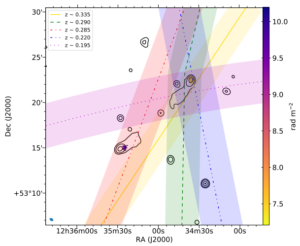IGM and LSS
Chairs: Valentina Vacca (OAC – INAF), Annalisa Bonafede (INAF) and Ettore Carretti (INAF – IRA)
Polarization and rotation measures
LOFAR observations are a powerful tool to investigate magnetic fields in filaments of the cosmic web. Faraday rotation measure and depolarization properties of background radio galaxies (Fig.1, O’Sullivan et al. 2019) can be compared with expectations of cosmological simulations in order to shed light on the origin of cosmic magnetism (Fig. 2, O’Sullivan et al. 2020).
 Figure 1: Location of foreground large-scale-structure filaments (lines) in relation to the background radio galaxy (contours) and its Faraday rotation measure (colour scale). The width of the lines corresponds to ∼1 Mpc at the redshift of the filament (O’Sullivan et al. 2019).
Figure 1: Location of foreground large-scale-structure filaments (lines) in relation to the background radio galaxy (contours) and its Faraday rotation measure (colour scale). The width of the lines corresponds to ∼1 Mpc at the redshift of the filament (O’Sullivan et al. 2019).
 Figure 2: Simulated distribution of the rotation measure structure function as a function of angular separation for three numerical models compared with LOFAR data. The solid lines show the mean values and the shaded region shows the 1σ dispersion (O’Sullivan et al. 2020).
Figure 2: Simulated distribution of the rotation measure structure function as a function of angular separation for three numerical models compared with LOFAR data. The solid lines show the mean values and the shaded region shows the 1σ dispersion (O’Sullivan et al. 2020).
Diffuse synchrotron radiation
A complementary tool is represented by radio observations of diffuse synchrotron sources. LOFAR is particularly suitable to study the properties of diffuse large-scale emission in galaxy clusters (Fig. 3 Vacca et al. in prep.) and filaments (Fig. 4, Govoni et al. 2019) since these sources are characterized by steep spectra and therefore brighter at low radio frequencies.
 Figure 3: Radio emission in contours and blue colors from the galaxy cluster A523 at 140 MHz with LOFAR at 20” (Vacca et al. in prep, in collaboration with SKSP and MKSP). Red colors represent the X-ray emission of the cluster from XMM-Newton data (Cova et al. 2019).
Figure 3: Radio emission in contours and blue colors from the galaxy cluster A523 at 140 MHz with LOFAR at 20” (Vacca et al. in prep, in collaboration with SKSP and MKSP). Red colors represent the X-ray emission of the cluster from XMM-Newton data (Cova et al. 2019).
 Figure 4: A radio ridge connecting two galaxy clusters in a filament of the cosmic web” (Govoni et al. 2019, Science). Optical: DSS and Pan-STARSS1 (insets); Red, X-rays: XMM-Newton; Yellow, y-parameter: PLANCK satellite; Blue, radio 140 MHz: LOFAR. Image credits: Matteo Murgia (INAF).
Figure 4: A radio ridge connecting two galaxy clusters in a filament of the cosmic web” (Govoni et al. 2019, Science). Optical: DSS and Pan-STARSS1 (insets); Red, X-rays: XMM-Newton; Yellow, y-parameter: PLANCK satellite; Blue, radio 140 MHz: LOFAR. Image credits: Matteo Murgia (INAF).